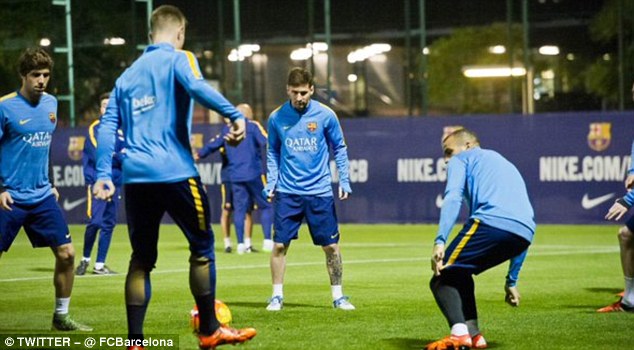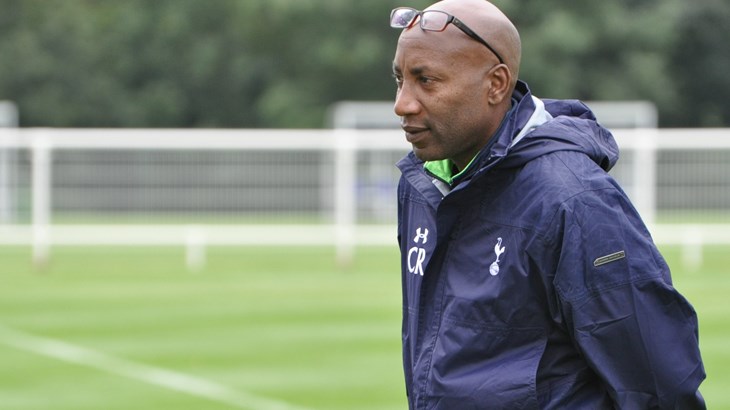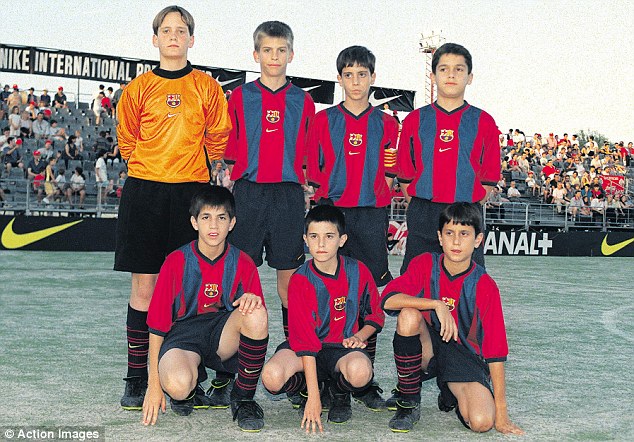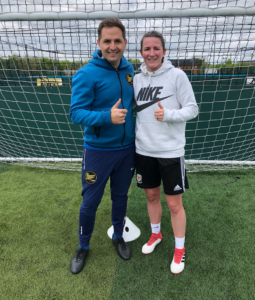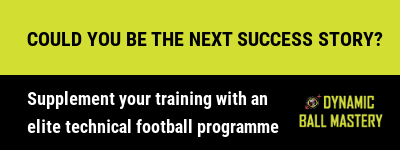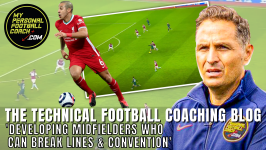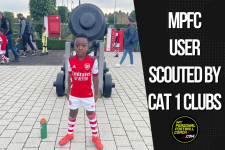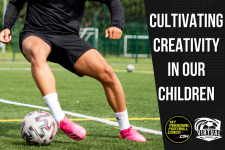Saul Isaksson-Hurst is an experienced premier league academy coach having spent 6 years at Tottenham Hotpsur FC and 4 years at Chelsea FC’s Academy as a Foundation Phase skills specialist and is founder of mypersonalfootballcoach.com where he is director of coaching. Saul talks about the benefits of practice away from the game work in particular, the Rondo drill which F.C. Barcelona have long been advocates of.
The last few weeks has seen US Soccer outlaw Rondo’s on their education courses as apparently it doesn’t ‘look like the game’. Also in England we have the continual battle to prove the merits of individual ball mastery as again, ‘it doesn’t translate to the game.’
When returning to England I got a job at Spurs and worked my way up into the Academy. My rise was quite fast, I put this down to my philosophy of individual ball mastery and 1v1 that I had brought back from the states, this was similar to the new philosophy under the Academy under John McDermott and Chris Ramsey. This was and still is unique within the Premier League Academy system, a methodology more commonly seen at Ajax and Dinamo Zagreb. This philosophy of individual ball mastery, a focus on the 1v1 and SSG’s helped drive the Tottenham Academy to be one of the best in the country.
I remember having Lunch at St Georges Park on my Advance Youth Award a couple of seasons ago, Dan Micciche happened to be on our table, one of my colleagues asked him if there was any club that you could tell “that player came from without knowing”, he said “Tottenham” mentioning the individual technical assets and their 1v1 capabilities.
The remarkable results at Spurs you would think that quality ball mastery and 1v1 work would be embraced by most in this country but still it hasn’t. In fact we have the opposite in relation to the Advance Youth Award where ball mastery and 1v1 hasn’t been seen as being relevant enough to include.
One of the other presentations was done by a former senior employee of the FA and who now works for a national Coaching organisation. His main theme was that anything done out of a game context doesn’t translate to the game and is a waste of time. He had a very well constructed presentation which included a map of Iniesta’s first touches in a game, these were at all different heights and speeds so this he argued is proof that working away from the game is pointless as you can’t replicate this.
I’ve seen this argument before and I have 2 contentions with it, firstly, the player himself, Iniesta arrived at Barcelona at 12, during this time the Academy spent a lot of time doing unopposed technical practices, the very thing this individual is arguing against. Surely it would be better to choose a player as an example that didn’t have this type of background. You will hear a lot of noise about Barcelona but hear it from the horses mouth here, with my interview with Albert Capellas the Head of Youth at La Masia when Iniesta was there – Interview with Alpert Capellas (Ex Youth Coordinator of F.C. Barcelona’s Academy.
There is a misunderstanding and ignorance about what this type of work looks like. It’s always done for a purpose and linked to the game. Now let me first clarify that unopposed work has evolved, it’s not a player dribbling to a cone doing a turn and then dribbling back again. I don’t use cones when doing ball mastery either in my team sessions or my individual session, only to mark out the area. Also it must always be challenging and focused so we can call it deliberate practice.
When we do dynamic ball mastery which may be high intensity skill combinations, it’s to challenge the players movement and control with ball, exactly for the reason above that the ball that comes at Iniesta at all different heights and speeds. The same reason Tiger Woods always practiced the hardest of shots from the most impossible lies/positions. Players want to be masters of the ball, so in a game they can react. Now the ‘specialists’ will argue this is nonsensical because there is no Perception-Action Coupling involving decision making.
I have been struggling with this notion for many years. Since many years ago taking the FA Youth Module 3 and being told theres no such thing as 1v1 and unopposed ball mastery “has nothing to do with football”. Also the continual noise on social media from ‘specialists’ and my work being attacked by many including a now former senior FA employee and from people including Stuart Armstrong, Head of Coaching at Sport England who suggested my work wasn’t progressive and who described my work with players as Coach porn, designed to titillate and beguile those who don’t know any better (Armstrong 2016).
Am I really that bad? To deserve this slander from the Head of Coaching at Sport England, someone who should be a colleague? Is the work I’m doing really that ineffective? To be attacked by someone within a governing body in such a high position was a little demoralising, I’m not going to lie. To attack my work is to attack the work of Chris Ramsey and John Mcdermott. Two people recently given awards for outstanding achievement to Youth Football in England by the FA.
As much as I self reflected, analysed and sometimes doubted my own work, the messages that I was getting back from the players didn’t correspond with this. I’ve recently been working 121 with Helen Ward, Watford and Wales International. She’s recently been on a Wales camp and played against Bosnia, I messaged her to ask how she’s getting on?
“Won 1-0 ? played 89 minutes, won a penalty, had it saved and assisted the winner! Lots of people commented on how sharp I looked and that the ‘1:1 guy must be helping’ so thanks!” (Helen Ward 2018)
Whether I’m working with Pro’s, young Academy players or newcomers to the game, the message is always the same, their confidence on the ball improves and this has an effect on their performances…a clear translation from the training pitch to the game.
But what about the Perception-Action Coupling? …in my opinion there is this process at work. The Perception-Action Coupling comes with the players reacting, learning and responding how there body responds to the ball and vice versa. This is why we see this extreme ball mastery in all elite sport settings. This is always a supplement to the game.
How we perceive the information surrounding us will always have an effect on our movements. For elite soccer players, an improved Perception-Action Coupling with ball mastery will mean that they are able to produce a more appropriate movement for the task. As with Iniesta controlling the ball at all different heights and velocities, the ball moving towards the player and how they receive and distribute is the environment of the player. The other factors then come into this. I.e other players.
The players have to cope and manage the ball in all these experiences, this leads to an automaticity in the game. Another one of my clients Nya Kirby, Crystal Palace & England Pro and U17 World Cup winner describes “Unopposed work allows everything to come natural in a game as it becomes instinct” (Nya Kirby 2017). Doug Lemov describes the benefit of automaticity in games.
What this means is that at certain points in the game their mind has gotten access to a new processing capacity because complex actions have come to require a small percentage of available capacity (Doug Lemov 2012).
Lemov actually describes that drills are actually essential at the higher level. He argues that this higher level of thinking and creativity isn’t actually possible unless players have this strong technical base built through repetition. That’s why, (as those of us who work with elite players know) players spend so much time away from training on the ball.
Now I’m not endorsing doing more drills in your team sessions, as I have said consistently, most should be game like. What I am saying is that time away from the game is just as important. Now this may contradict many of the ‘specialists’ who argue the work away from the game and in isolation doesn’t improve but actually hinders decision making, Lemov rejects this.
The problem with this argument is that generally learning doesn’t work that way. As cognitive scientists like Daniel Willingham have shown, its all but impossible to have higher-order thinking without strongly established skills and lots of knowledge of facts. Cognitive leaps, intuition, inspiration-the stuff of vision-are facilitated by expending the smallest possible amount of processing capacity on lower-order aspects of a problem and reapplying at higher levels (Willingham 2012).
This makes perfect sense to me, as an experienced foundation phase (8-11s) practitioner and also an experienced primary school teacher. I remember my time at Spurs, players used to have to do 75’s every session, this would be players in pairs doing 25 passes strong foot, 25 passes weak and 25 both (2 touch). This was getting that basic repetition, building that motor control and muscle memory of a basic 5-8 yard pass. We make the basics automatic so players can be more creative.
Have to say that in middle age I drifted away from drilling technique. Actually “lured” back by excellent results I saw in team games, including football. Think we need to be careful we don’t ignore old wisdom. The military and musicians drill and it works for them so…?! (Collins 2018)
Collins has always said there’s no evidence that a Constraints Led Approach is the right and only way. He has continually said that it depends on the individual.
“I don’t think we give enough consideration to the advantages of drill-like practices. Balance is Key…No one way…it depends! (Collins 2018)
Like I said I’m not here promoting more drills in your sessions. We are hearing so much noise about the effectiveness of working in a game and the ineffectiveness of working out if and its important to clarify that its not universal through academia.
When I was on the Advance Youth Award recently, which is an excellent course by the way, a sport scientist was presenting, he has some really interesting work but he has been one of the main drivers of the game based approached and high contextual interference sessions. He suggested 11v11 would be the best format for Foundation Phase players as it’s the closest to the real game.
This is where we as experienced practitioners can see through the data, and have an advantage over the sport Scientists, for me its about quality rather than quantity sometimes. The Man Utd 4v4 project showed us the contrast between playing 4v4 to an 8v8. 1v1 encounters increased by 225%, 1v1 skills increased by 280%, there was also 500% more goals and 135% more passes. As developers we want to get our players making decisions on the ball as much as possible! These are surely the type of outcomes we want in our sessions?This has often been my contention with the new constraints based approach,its often associated to larger formatted SSG’s. 7V7, 8V8, 9V9 in training, where you may get good decisions and team based outcomes, how many touches on the ball are your players getting? Are they making decisions on the ball? Particularly in the foundation phase, is this really the most effective use of players training time? Are we training towards the game on the weekend or are we training to develop individuals?
Back to the Rondo, and in the same vein its not seen as realistic enough to merit inclusion in coach development in the USA. We all know about Pep and Barcelona’s love affair with this particular exercise. I’ve been lucky enough to travel all around the world and seen the effective use of the Rondo. Lemov argues about You build mastery in layers, which means training sessions should layer in new information and complexity gradually (Lemov 2012) this for me is exactly What the Rondo does. Its a great introduction to the principles of possession and has use at the beginning all the way to the end of players Journey, that’s why its universally used in elite environments across the world.
There are no definite in soccer as in anything else in the world. We must strive to do the best for our players and learn and evolve as coaches. In a world of twitter coaches and specialists with little or no practical experience in the area they promote we should strive to look for proof in anything we do. But remember…each individual is different…there’s no one way!
For more professional tips, drills and exercises, get your subscription to the Dynamic Ball Mastery programme; the worlds leading online technical soccer resource.
We currently have a Summer Sale on all of our products, use ‘SUMMER25’ for 25% off! This deal will end on 1st July.
Master the ball master the game!


